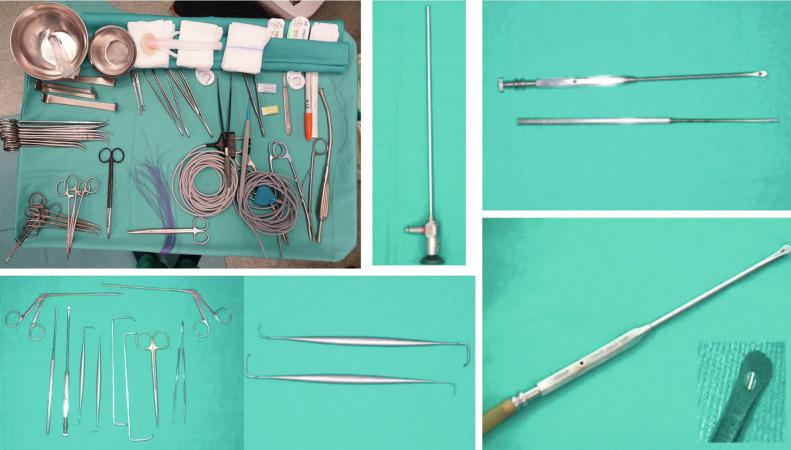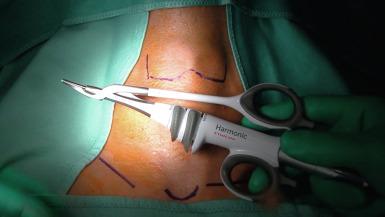Physical Address
304 North Cardinal St.
Dorchester Center, MA 02124
Minimally Invasive Video-Assisted Thyroidectomy.
![]() This chapter contains additional online-only content, including exclusive video, available on expertconsult.com .
This chapter contains additional online-only content, including exclusive video, available on expertconsult.com .
The conventional surgery for neck endocrine diseases is generally performed using traditional Kocher incision, which is characterized by a standard skin incision and results in a visible, large scar on the neck (see Chapter 31 , Principles in Thyroid Surgery). For minimally invasive neck endocrine surgery, a variety of techniques are available, some of which require the use of a surgical endoscope; however, others do not. The different minimally invasive techniques using an endoscope can be classified in purely endoscopic and video-assisted procedures. In the totally endoscopic techniques, surgical dissection is completely carried out under endoscopic vision. This requires a continuous carbon dioxide (CO 2 ) insufflation or the use of external devices (retractors) to maintain the operative space for dissection and trocar positioning. These totally endoscopic approaches are generally more technically demanding in comparison with the conventional techniques and can be difficult to reproduce in different settings. As a general result, the totally endoscopic procedures have a more limited acceptance. However, minimally invasive video-assisted parathyroidectomy (MIVAP) (see Chapter 58 , Minimally Invasive Video-Assisted Parathyroidectomy) and minimally invasive video-assisted thyroidectomy (MIVAT), have gained large, worldwide acceptance, which began shortly after their introduction during the late 1990s. This is likely attributable to the advantages related to endoscopic magnification coupled with the fact that these procedures share many features of conventional surgery. MIVAP and MIVAT are completely gasless procedures that reproduce all the steps of the conventional operation. The endoscope represents a tool that allows performance of the same basic operation through a very minimal skin incision thanks to magnification.
MIVAP and MIVAT are associated with a minimal incision and optimal cosmetic result. Moreover, the absence of neck hyperextension and extensive dissections results in less postoperative pain. Several comparative studies have demonstrated MIVAT superiority in terms of reduced postoperative pain, better cosmetic results, and higher patient satisfaction over the conventional thyroidectomy. Furthermore, data from multicenter studies on a large series of patients showed that MIVAT is a safe, effective, and reproducible technique. MIVAT also allows for the option of locoregional anesthesia (cervical block).
In one retrospective study, we demonstrated that thyroid gland manipulation is not substantially different from MIVAT and conventional thyroidectomy; there is no additional risk of thyroid capsule rupture with thyroid cells seeding in patients who undergo MIVAT. Many authors have demonstrated the applicability of treating thyroid malignancy with a video-assisted approach. Studies comparing the results of MIVAT and conventional thyroidectomy, in terms of adequacy of surgical resection, showed that MIVAT is safe and effective for the treatment of small papillary thyroid carcinomas (PTCs) and has similar oncological effectiveness when compared with traditional thyroidectomy.
We have applied this video-assisted technique to lymph node dissections (VALD) of the central compartment (see Chapter 38 , Central Neck Dissection: Indication and Technique) in cases of incidental discovery of lymph node enlargement during MIVAT for PTC or for suspicious nodules. Finally, we evaluated the feasibility of minimally invasive video-assisted functional lateral neck dissection (VALNED) (see Chapter 39 , Lateral Neck Dissection: Indication and Technique) in patients with PTC and we yielded encouraging results. Larger series and comparative studies are necessary for definitive conclusions.
Appropriate patient selection is key to the success of MIVAT. In early experiences with MIVAT, the indications were quite limited; initial contraindications included thyroiditis and prior neck surgery. With increasing experience, selection criteria for MIVAT have become widened. Based on the surgeons’ experience, patients with previous contralateral video-assisted neck surgery or thyroiditis can be safely selected for MIVAT. Expanded indications include patients who have undergone video-assisted thyroid lobectomy needing a completion thyroidectomy and for selected patients with Graves’ disease, where MIVAT can be performed safely with results comparable with open surgery. In our experience, it has also been possible to perform MIVAT in cases of nodules > 35 mm in diameter. We believe that a preoperative diagnosis of PTC with lymph-node involvement represents a contraindication for MIVAT. More recently, some have applied the technique to carry out a prophylactic thyroidectomy and central compartment lymphadenectomy in patients carrying the rearranged during transfection (RET) oncogene mutation for familial medullary thyroid carcinoma (see Chapter 27 , Syndromic Medullary Thyroid Carcinoma: MEN 2A and MEN 2B).
For the most part, surgical instruments necessary for MIVAT are typically available in almost all operating rooms. The only instruments not commonly used for a conventional thyroidectomy are small (2 to 3 mm in diameter), dedicated, reusable tools (e.g., spatulas and spatulas-shaped aspiration) necessary for dissection ( Figure 34.1 ). Ultrasound knife system (Ultracision®, Harmonic Focus Plus®) ( Figure 34.2 ) is of great utility in this kind of operation and has been shown to be associated with reduction of operative time.


Become a Clinical Tree membership for Full access and enjoy Unlimited articles
If you are a member. Log in here